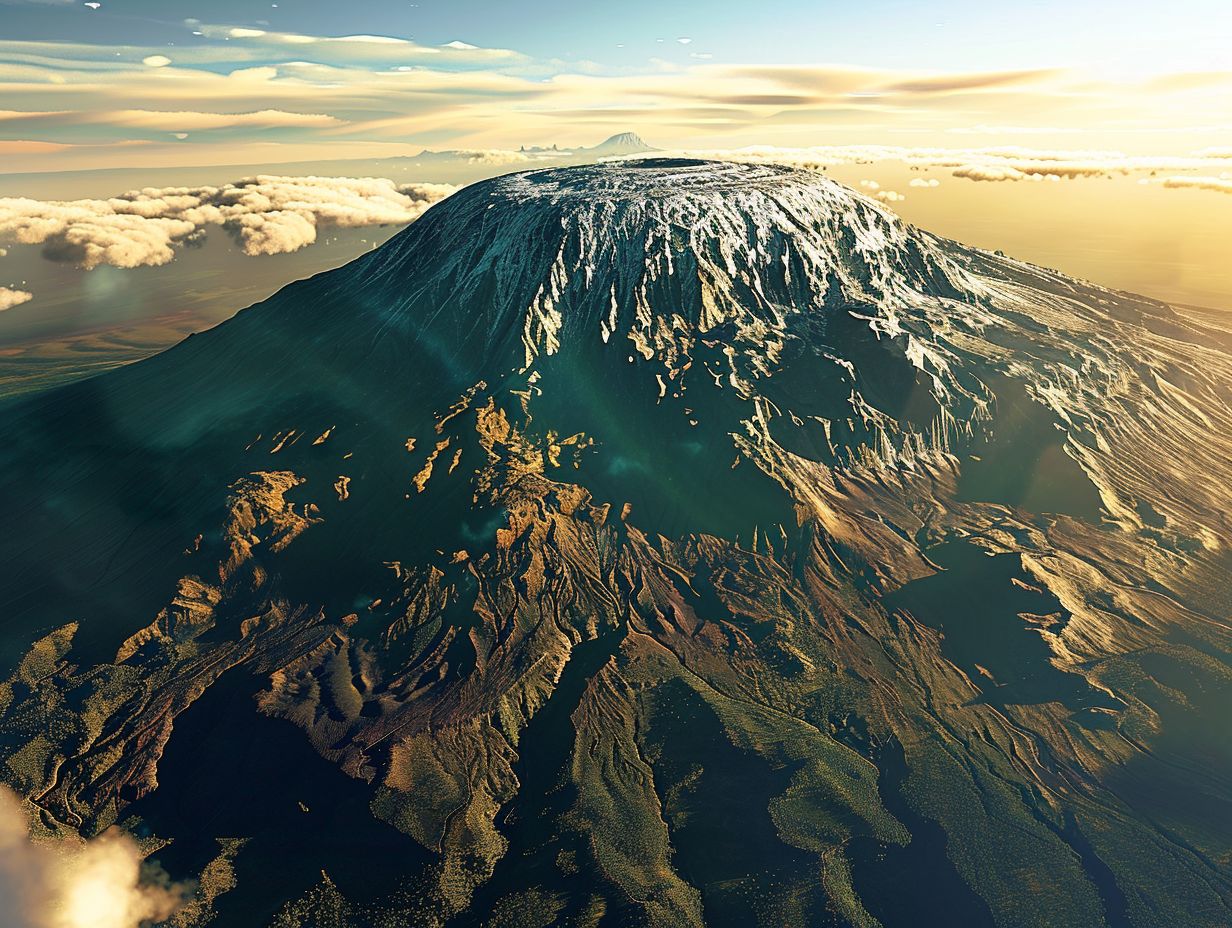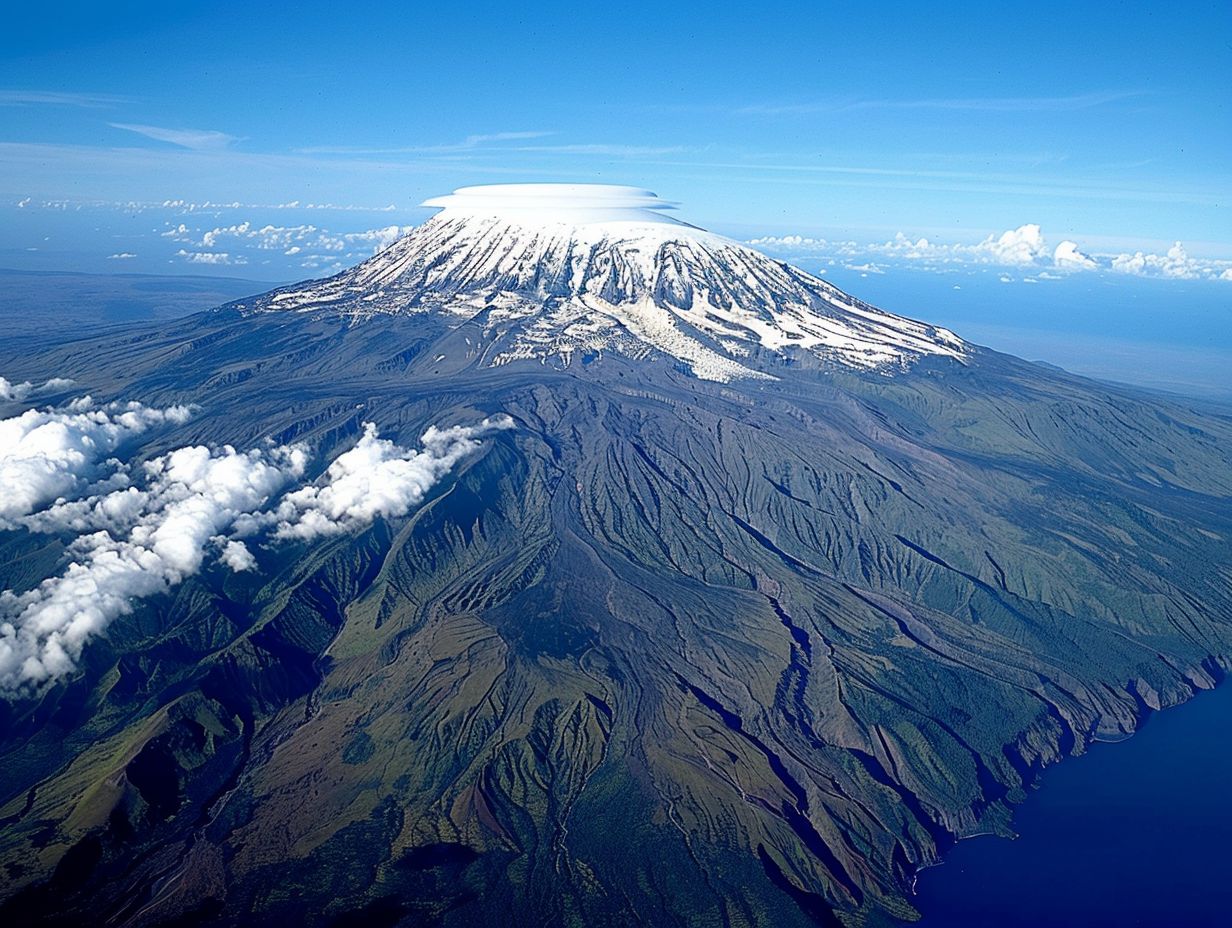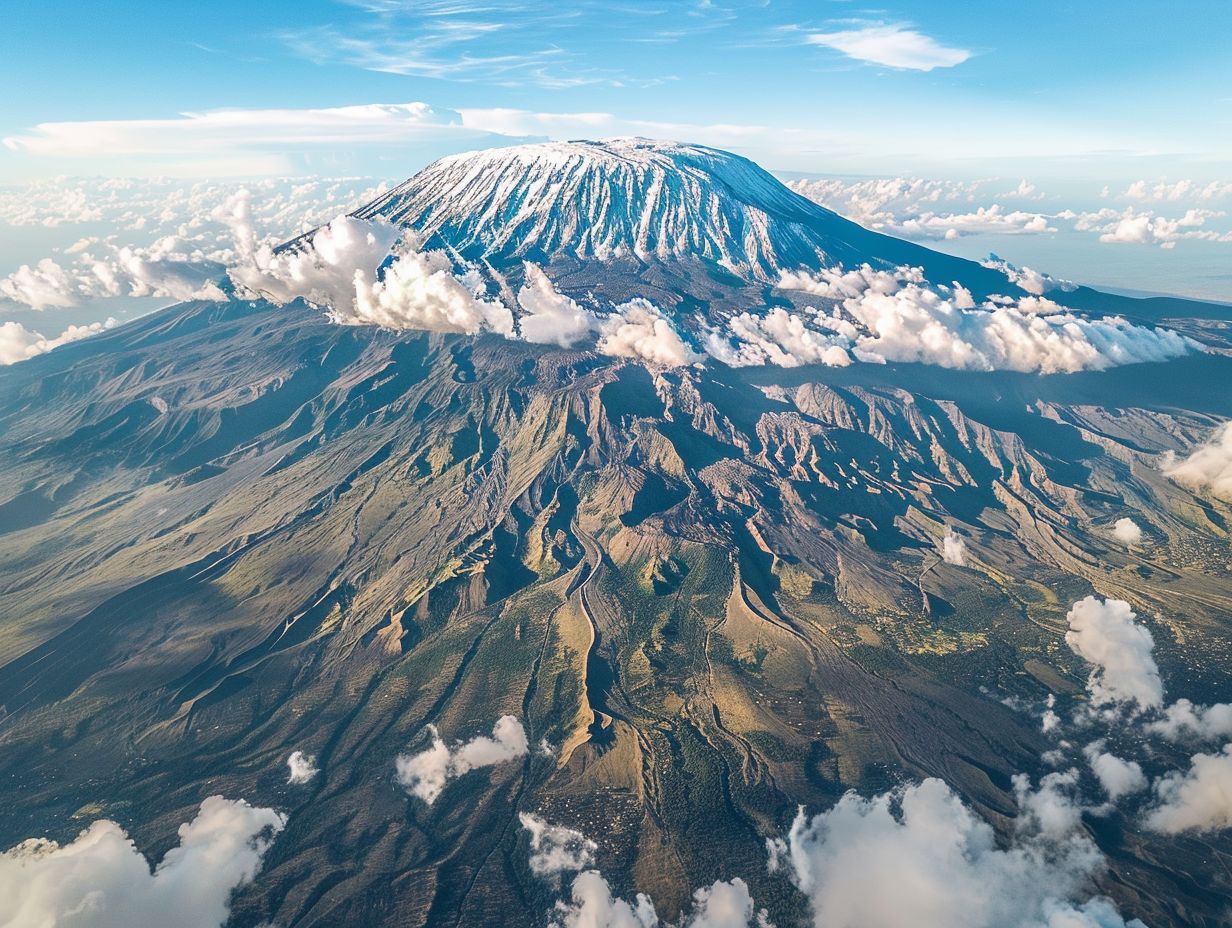
Mount Kilimanjaro, the iconic mountain in Tanzania, is not just any mountain – it is actually a volcano. In this article, we will explore the different types of volcanoes and delve into the specific characteristics of Mount Kilimanjaro. From its formation to its eruptions, we will uncover the secrets of this majestic volcano.
We will discuss the potential hazards of Mount Kilimanjaro and its impact on the surrounding environment. For the adventurous souls looking to climb this wonder, we will provide tips, precautions, and routes for a successful journey to the peak. Join us on this thrilling exploration of Mount Kilimanjaro!
Key Takeaways:

- Mount Kilimanjaro is a stratovolcano, also known as a composite volcano, characterized by steep slopes and explosive eruptions.
- The formation of Mount Kilimanjaro is a result of the interaction between the African and Eurasian tectonic plates, which created a weak spot in the Earth’s crust.
- Despite being considered a dormant volcano, Mount Kilimanjaro poses potential hazards such as landslides, ash plumes, and lava flows that can affect the surrounding environment and communities.
What Kind of Volcano is Mount Kilimanjaro?
Mount Kilimanjaro is a dormant stratovolcano located in Tanzania, East Africa, known for its towering height and distinctive volcanic cone shape.
With its summit at Uhuru Peak, standing at approximately 19,341 feet (5,895 meters) above sea level, Kilimanjaro is the highest peak in Africa, attracting adventurers and nature enthusiasts from around the globe. The mountain is composed of three distinct volcanic cones – Kibo, Mawenzi, and Shira – each showcasing different volcanic activities from its past.
Due to its unique geological features and diverse ecosystems, Kilimanjaro is designated as a UNESCO World Heritage Site, adding to its significance as a natural wonder in Tanzania.
What Are the Characteristics of Mount Kilimanjaro?
Mount Kilimanjaro boasts multiple peaks, including Kibo, Mawenzi, and Shira, with Uhuru Peak being the highest summit, crowned with glaciers and an ice cap.
The glaciers on Kilimanjaro, such as the Furtwängler Glacier, are renowned for their shimmering beauty and are a striking contrast against the African landscape. These glaciers are unparalleled in Africa, attracting climbers and enthusiasts from around the world.
The ice formations on the mountain are not only breathtaking but also a critical marker of the impact of climate change. The diversity of landscapes on Kilimanjaro, from lush rainforests to alpine meadows, provides a unique experience for visitors exploring this iconic destination.
How Was Mount Kilimanjaro Formed?

Mount Kilimanjaro was formed through successive volcanic eruptions that built up its three main volcanic cones – Kibo, Mawenzi, and Shira – over geological time, leaving behind distinct ash pits and rock formations.
The formation of Mount Kilimanjaro began millions of years ago, with intense volcanic activity shaping its landscape. The first cone to emerge was Shira, believed to have been active about 2.5 million years ago. As volcanic eruptions continued, the peaks of Kibo and Mawenzi gradually took form, creating the majestic summit we see today.
Each cone represents a different phase of volcanic activity, showcasing the diverse geological processes that contributed to Kilimanjaro’s unique composition. The ash pits scattered across the mountain testify to the explosive nature of these eruptions, while the intricate rock formations bear witness to the gradual cooling and solidification of lava flows over time.
What Are the Eruptions of Mount Kilimanjaro?
Mount Kilimanjaro has experienced historical eruptions that contributed to its current geological features, including the presence of ice fields, fumaroles, and distinctive stratigraphy in its volcanic deposits.
These eruptions, dating back thousands of years, have sculpted the terrain of Kilimanjaro, shaping its breathtaking landscape. The eruption activity played a pivotal role in the formation of the ice fields atop the mountain, creating a unique juxtaposition of tropical climate and snow-capped peaks.
Fumaroles, which are openings in the Earth’s crust that emit steam and gases, are a testament to Kilimanjaro’s volcanic history. The stratigraphic layers found in the volcanic deposits provide a chronological record of the mountain’s eruptive past, offering valuable insights to geologists studying its geological evolution.
How Active is Mount Kilimanjaro?
Mount Kilimanjaro is currently considered a dormant volcano, monitored by geologists and seismologists for any signs of volcanic activity, while also facing challenges such as glacial retreat due to climate change.
Geologists and seismologists utilize various techniques to track the volcanic activity of Mount Kilimanjaro, such as measuring gas emissions, seismic activity, and ground deformation. Continuous monitoring is crucial to detect any early warning signs of potential eruptions and assess the volcano’s stability.
The ongoing glacial retreat on Kilimanjaro is linked to global climate change, affecting the mountain’s water resources and ecosystem. The loss of glaciers alters the hydrological balance and poses long-term implications for local communities dependent on the mountain’s resources for water supply and agriculture.
What Are the Potential Hazards of Mount Kilimanjaro?
Despite its dormant status, Mount Kilimanjaro poses potential hazards such as rockfall, ash emissions from residual ash pits, and sporadic geothermal activity that need to be monitored for safety and research purposes.
Rockfalls on Mount Kilimanjaro can occur due to the weathering effects on its volcanic rocks, leading to unstable slopes and the risk of falling debris. Ash emissions from residual ash pits, remnants of past eruptions, may release harmful gases and particles into the air, affecting air quality and posing respiratory risks to climbers and nearby inhabitants.
The sporadic geothermal activity under the surface of the mountain can result in steam emissions and potential underground heat sources that may cause disturbances.
What Are the Effects of Mount Kilimanjaro on the Surrounding Environment?
Mount Kilimanjaro’s presence impacts its surrounding environment through climate patterns, glacial retreat affecting water resources, and the preservation of valuable ice core samples that offer insights into historical climate variations and geological features.
The climatic influence of Mount Kilimanjaro extends beyond its immediate vicinity, impacting weather patterns across the region. The gradual melting of glaciers on the mountain has significant implications for water sources that communities rely on for sustenance and agriculture.
Scientists study the ice core samples extracted from Kilimanjaro to unravel the Earth’s past climate patterns, enabling them to make projections about future environmental changes. The geographical features shaped by the mountain, such as the Great Rift Valley, play a crucial role in the local ecosystem and biodiversity.
Climbing Mount Kilimanjaro: Tips and Precautions

Climbing Mount Kilimanjaro is a popular adventure activity attracting tourists from around the world, requiring adequate preparation, physical fitness, and adherence to safety precautions to ensure a successful ascent.
Mount Kilimanjaro, standing majestically in Tanzania, offers a challenging yet rewarding experience to climbers. As you embark on this journey, mental preparation is just as crucial as physical readiness. The ascent involves various climate zones, from tropical to arctic, demanding adaptability and resilience. Acclimatization to altitude is essential to prevent altitude sickness, so gradual ascent and hydration are key.
With its diverse ecosystem, Kilimanjaro presents stunning landscapes, including the iconic snow-capped Uhuru Peak. Packing the right gear, such as sturdy hiking boots, warm clothing, and high-altitude essentials, is vital. Hiring experienced guides and porters enhances safety and enjoyment throughout the expedition.
What Are the Different Routes to Climb Mount Kilimanjaro?
Climbing Mount Kilimanjaro presents various routes to reach the summit, each offering unique challenges and scenic views, passing by notable landmarks such as the summit crater and parasitic cones along the way.
One of the most popular routes is the Marangu route, also known as the ‘Coca-Cola’ route, characterized by its gradual incline and hut accommodations. On the other hand, the Machame route, dubbed the ‘Whiskey’ route, is famous for its picturesque landscapes, challenging terrain, and higher summit success rates.
For those seeking a more remote experience, the Lemosho route provides a longer trek through diverse scenery, including lush rainforests and alpine desert.
Meanwhile, the Rongai route offers a less crowded ascent from the northern side, with stunning views of the Kenyan plains. The challenging Umbwe route is known for its steep slopes and direct paths, attracting experienced climbers looking for a tough adventure.
The Northern Circuit route encircles the mountain, allowing for gradual acclimatization and breathtaking panoramas from all sides.
What Are the Physical Demands of Climbing Mount Kilimanjaro?
The physical demands of climbing Mount Kilimanjaro include navigating glaciers, adjusting to altitude changes, and overcoming challenges posed by glacial retreat and volcanic ash pit remnants along the ascent.
Glacier navigation on Mount Kilimanjaro demands skill and caution due to constantly changing terrain and crevasses that can pose significant risks to climbers. Altitude acclimatization plays a crucial role in enabling climbers to adjust to the decreasing oxygen levels as they ascend, with many experiencing symptoms of altitude sickness along the way.
The impact of glacial retreat is evident in the changing landscape, with shrinking ice fields becoming more hazardous to traverse, while volcanic activity adds an element of unpredictability to the climb.
What Are the Safety Precautions to Take While Climbing Mount Kilimanjaro?
When embarking on a climb up Mount Kilimanjaro, it is essential to adhere to safety precautions such as staying informed about geothermal activity, following designated routes, and respecting the guidelines set by UNESCO as it is a World Heritage site.
Mount Kilimanjaro, the majestic peak standing tall as the highest in Africa, is not just a physical challenge but also a journey through unique ecosystems and diverse cultures. Understanding the geothermal activity in this region is crucial, as volcanic gases and hot springs can pose risks.
By sticking to established paths, climbers not only ensure their safety but also protect the delicate flora and fauna that call this mountain home. By honoring the regulations endorsed by UNESCO, visitors contribute to the preservation of the site’s rich natural and cultural heritage, fostering a sustainable approach to exploration.
Frequently Asked Questions
What kind of volcano is Mount Kilimanjaro?

Mount Kilimanjaro is a stratovolcano, also known as a composite volcano.
What makes Mount Kilimanjaro unique compared to other volcanoes?
Mount Kilimanjaro is the tallest volcano in Africa, standing at 19,341 feet, and is also the world’s tallest freestanding mountain.
How was Mount Kilimanjaro formed?
Mount Kilimanjaro was formed by the movement of tectonic plates, which created a weak spot in the Earth’s crust allowing magma to rise and form the volcano.
Is Mount Kilimanjaro currently active?
No, Mount Kilimanjaro is currently dormant, meaning it has not erupted in over 200 years. However, scientists still monitor the volcano for any signs of activity.
What type of eruptions does Mount Kilimanjaro have?
Mount Kilimanjaro is known for its explosive eruptions, which are caused by the high silica content and gas-rich magma that builds up pressure before erupting.
Are there any dangers associated with Mount Kilimanjaro’s volcanic activity?
While Mount Kilimanjaro is not currently active, there is still a risk of volcanic gases and minor earthquakes in the area. It is also important for climbers to be aware of altitude sickness due to the volcano’s high elevation.